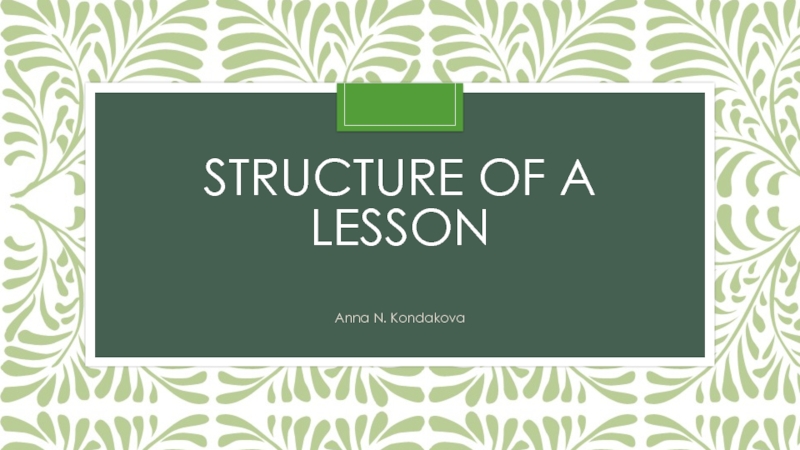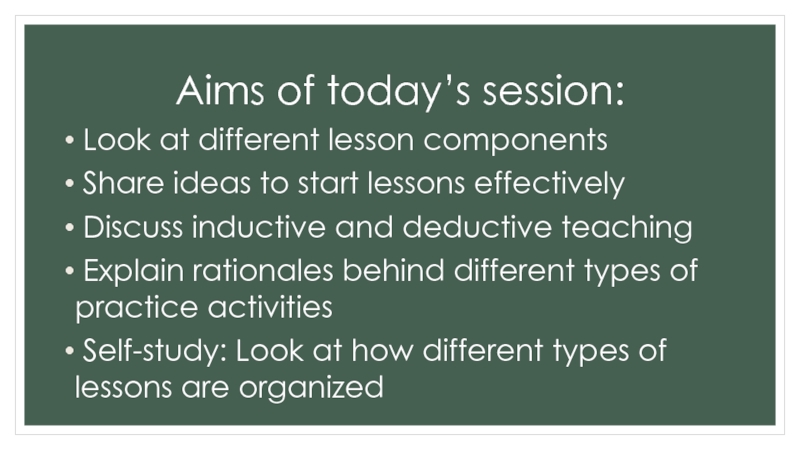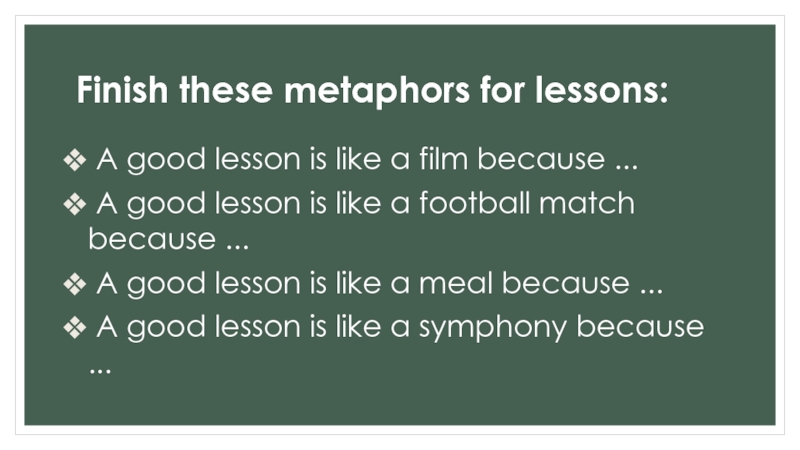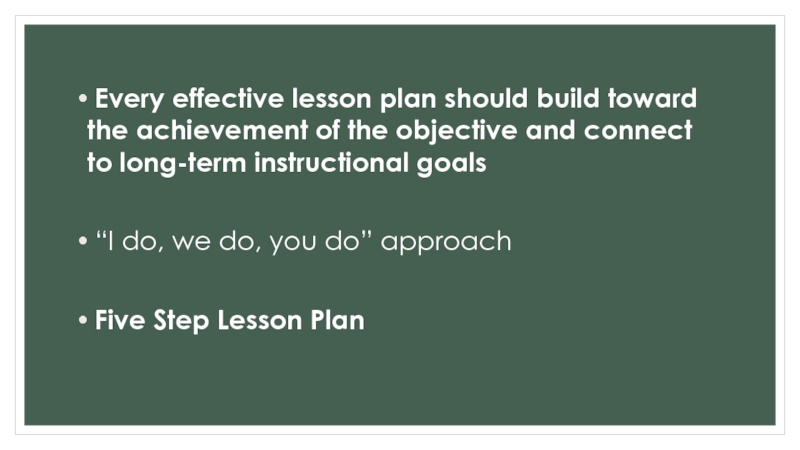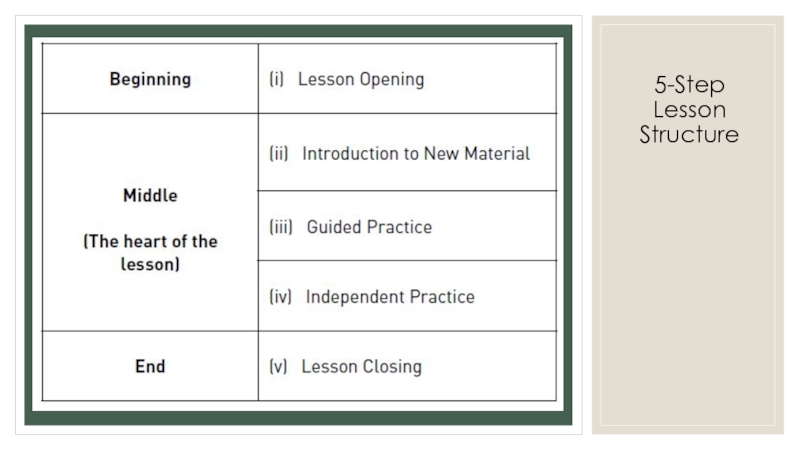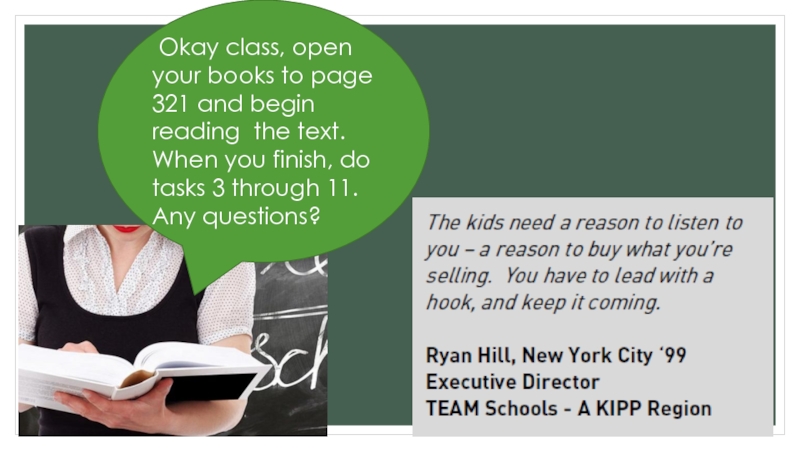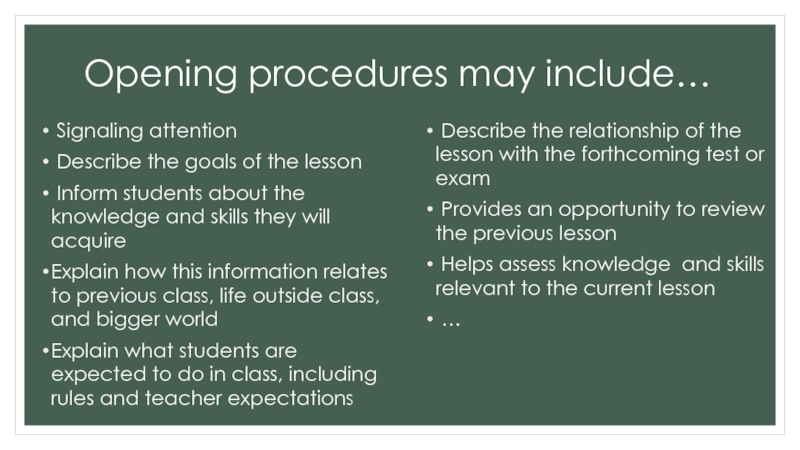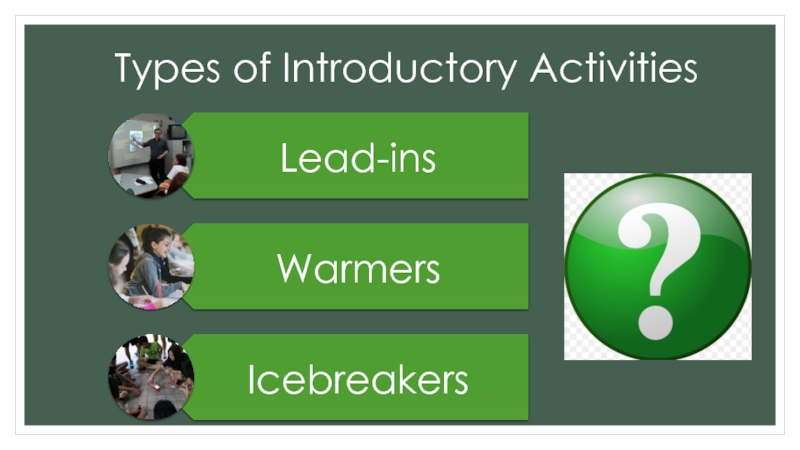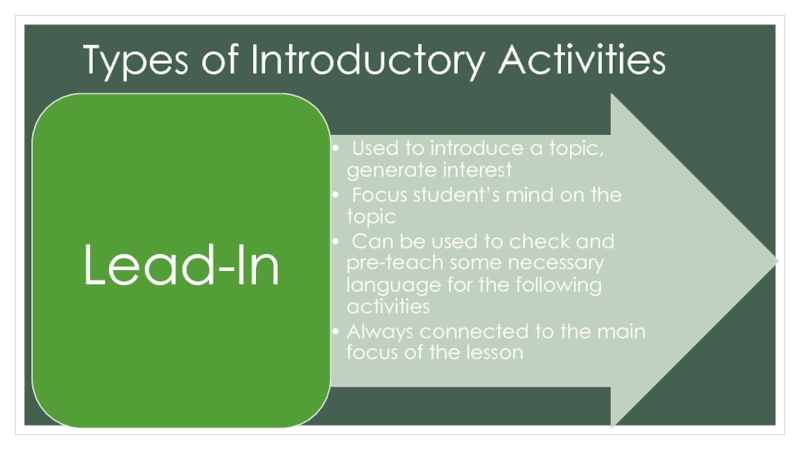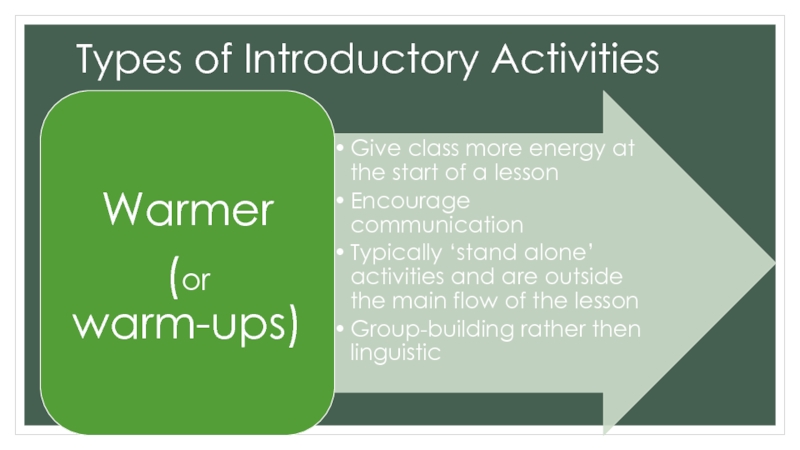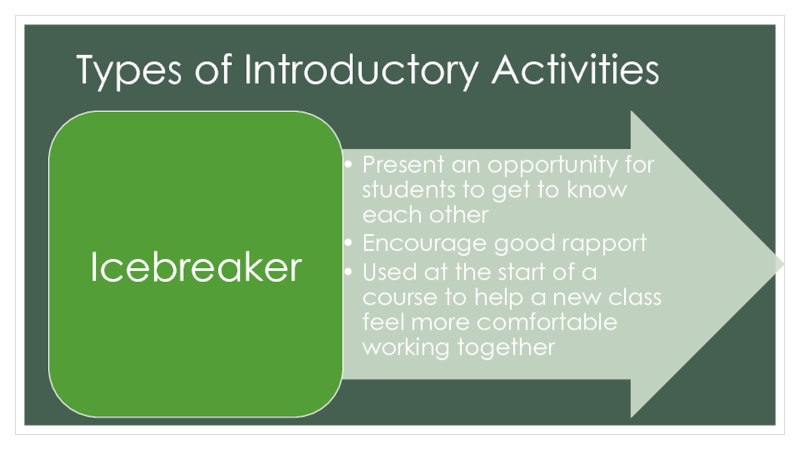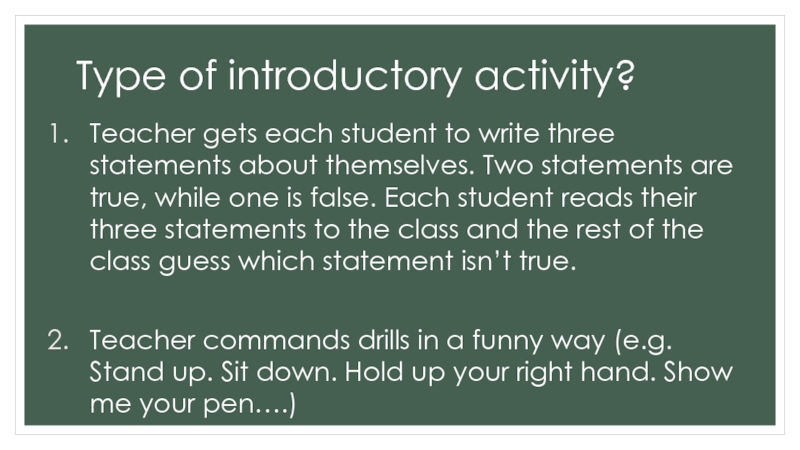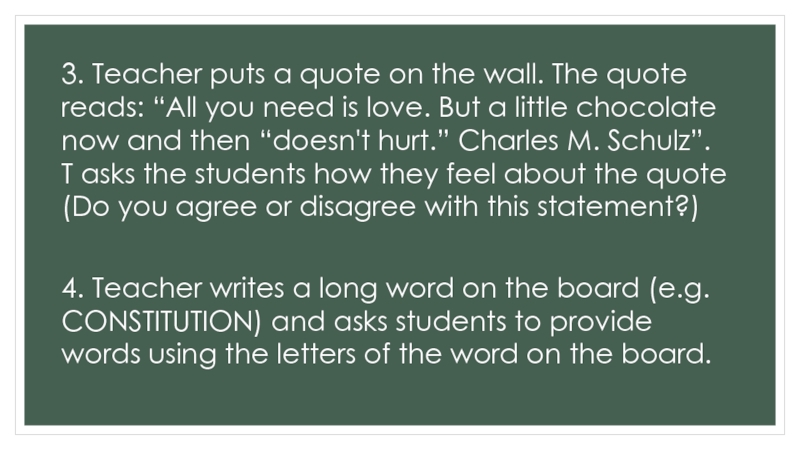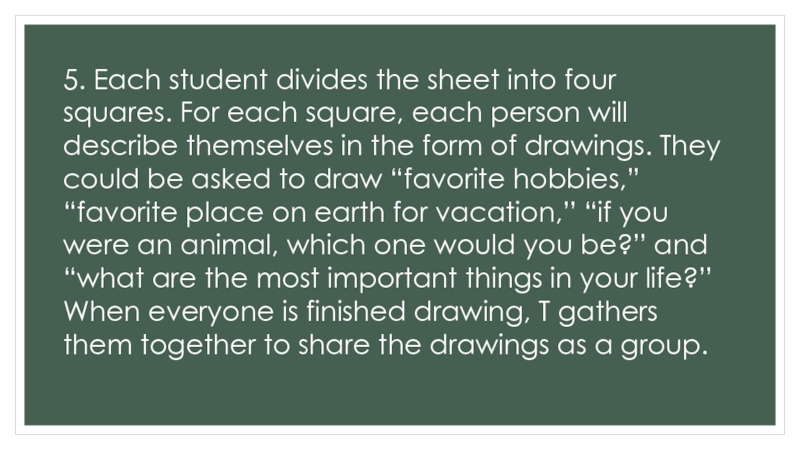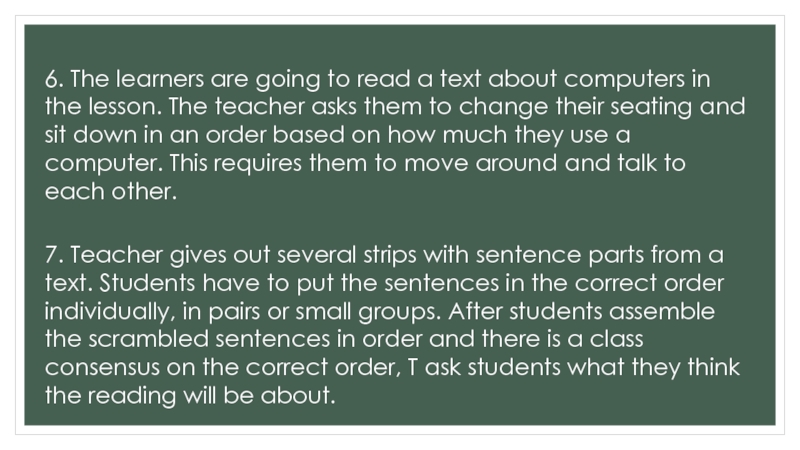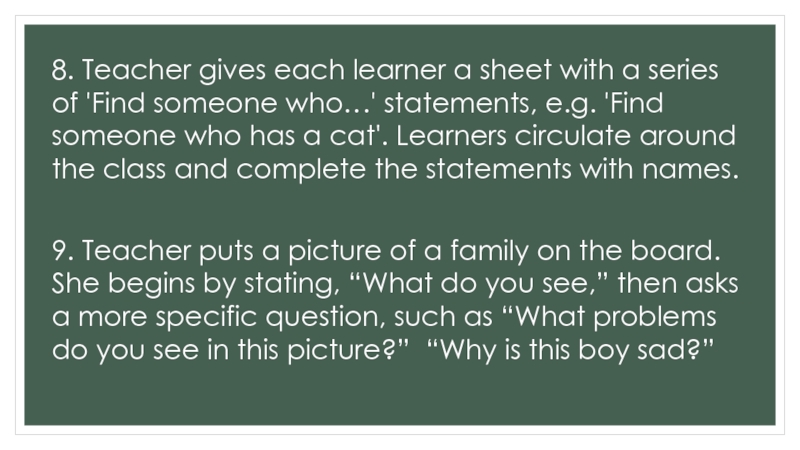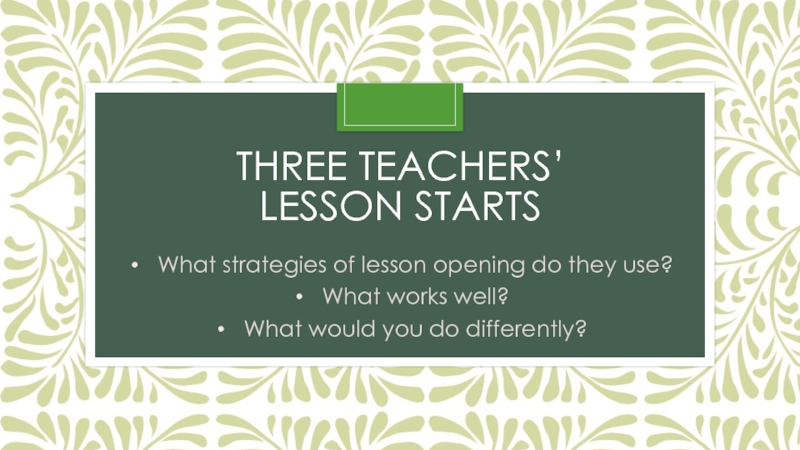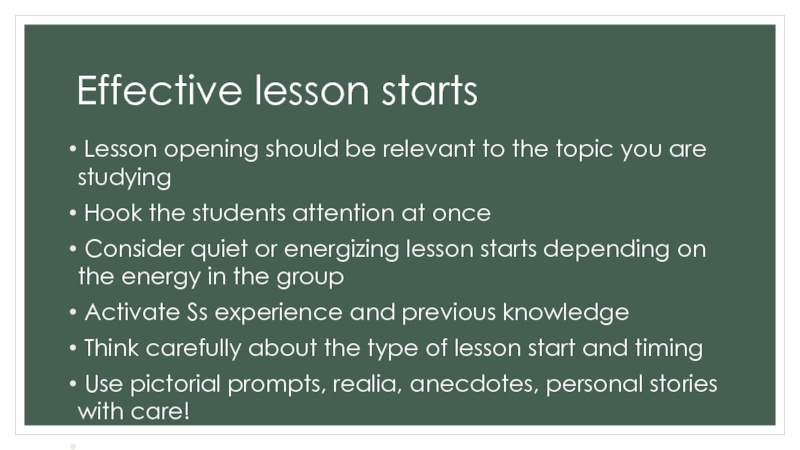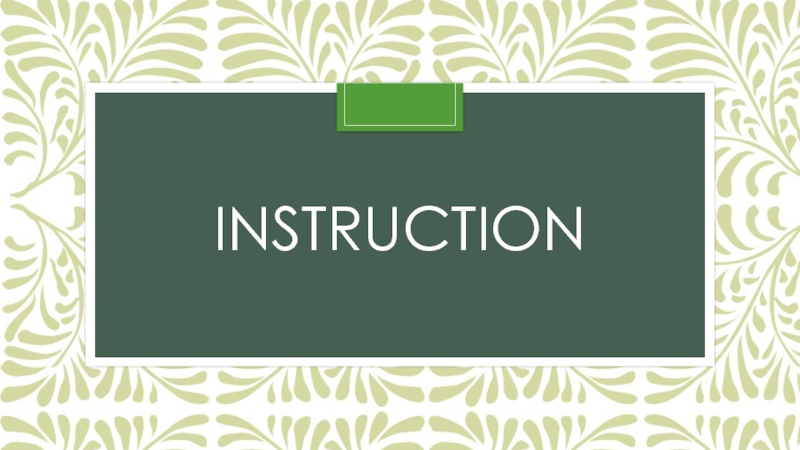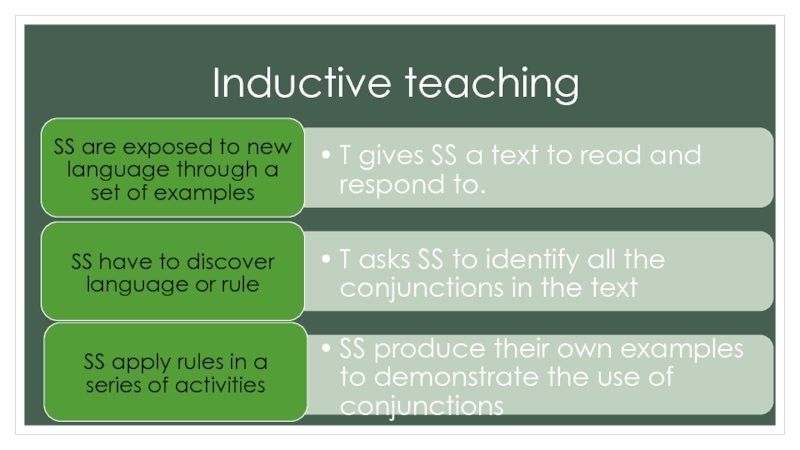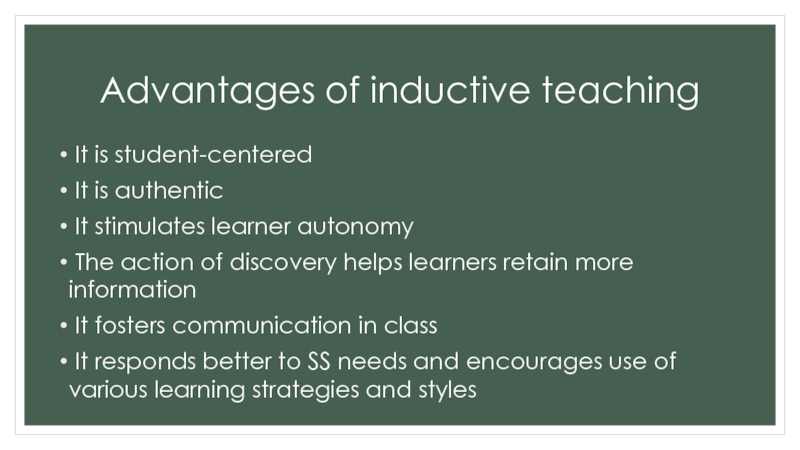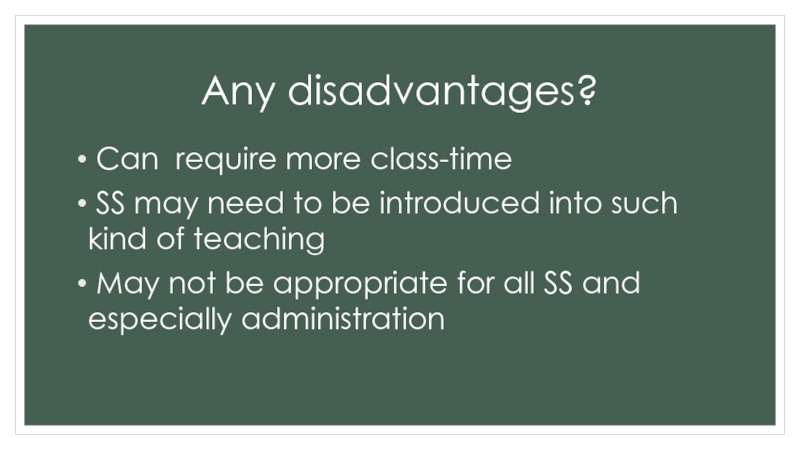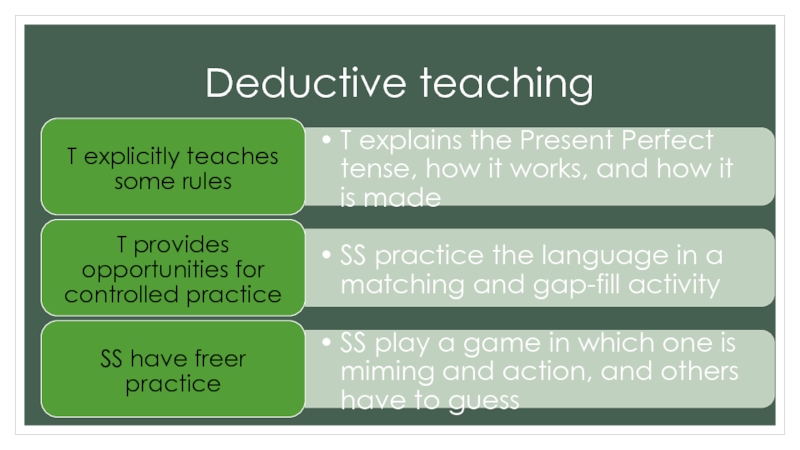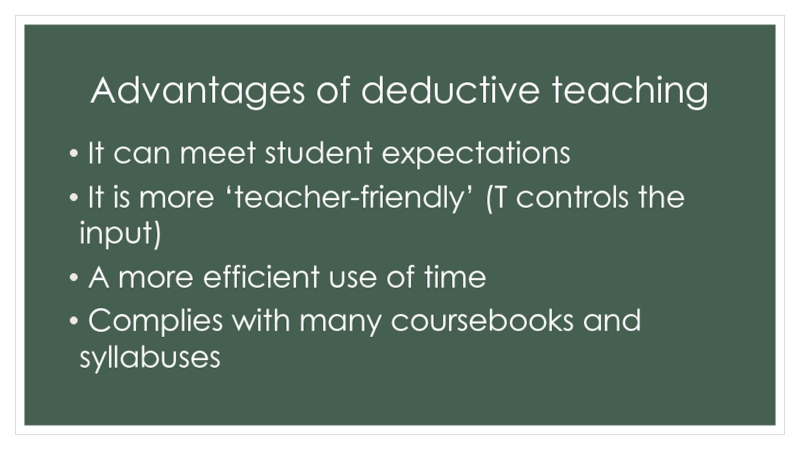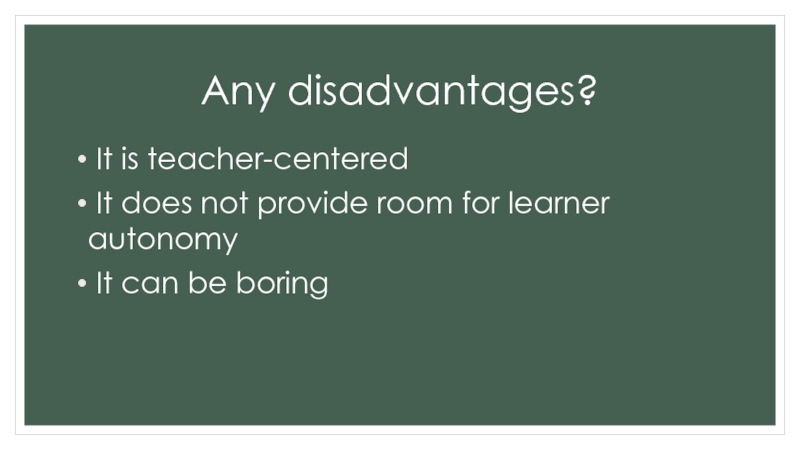- Главная
- Разное
- Дизайн
- Бизнес и предпринимательство
- Аналитика
- Образование
- Развлечения
- Красота и здоровье
- Финансы
- Государство
- Путешествия
- Спорт
- Недвижимость
- Армия
- Графика
- Культурология
- Еда и кулинария
- Лингвистика
- Английский язык
- Астрономия
- Алгебра
- Биология
- География
- Детские презентации
- Информатика
- История
- Литература
- Маркетинг
- Математика
- Медицина
- Менеджмент
- Музыка
- МХК
- Немецкий язык
- ОБЖ
- Обществознание
- Окружающий мир
- Педагогика
- Русский язык
- Технология
- Физика
- Философия
- Химия
- Шаблоны, картинки для презентаций
- Экология
- Экономика
- Юриспруденция
Structure of a lesson презентация
Содержание
- 1. Structure of a lesson
- 2. Aims of today’s session: Look at
- 3. Finish these metaphors for lessons: A
- 4. Every effective lesson plan should build
- 5. 5-Step Lesson Structure
- 6. Okay class, open your books to
- 7. Opening procedures may include… Signaling attention
- 8. Types of Introductory Activities
- 9. Types of Introductory Activities
- 10. Types of Introductory Activities
- 11. Types of Introductory Activities
- 12. Type of introductory activity? Teacher gets each
- 13. 3. Teacher puts a quote on the
- 14. 5. Each student divides the sheet into
- 15. 6. The learners are going to read
- 16. 8. Teacher gives each learner a sheet
- 17. THREE TEACHERS’ LESSON STARTS What strategies
- 18. Effective lesson starts Lesson opening should
- 19. INSTRUCTION
- 20. Inductive teaching
- 21. Advantages of inductive teaching It is
- 22. Any disadvantages? Can require more class-time
- 23. Deductive teaching
- 24. Advantages of deductive teaching It can
- 25. Any disadvantages? It is teacher-centered
- 26. Video Watch two teachers presenting instruction
- 27. Types of lessons Reading skills lessons
- 28. Making reading communicative https://www.teachingenglish.org.uk/article/making-reading-communicative A
- 29. Planning a grammar lesson http://www.teachingenglish.org.uk/article/planning-a-grammar-lesson Improving
- 30. THANK YOU!
Слайд 2Aims of today’s session:
Look at different lesson components
Share ideas
to start lessons effectively
Discuss inductive and deductive teaching
Explain rationales behind different types of practice activities
Self-study: Look at how different types of lessons are organized
Discuss inductive and deductive teaching
Explain rationales behind different types of practice activities
Self-study: Look at how different types of lessons are organized
Слайд 3Finish these metaphors for lessons:
A good lesson is like a
film because ...
A good lesson is like a football match because ...
A good lesson is like a meal because ...
A good lesson is like a symphony because ...
A good lesson is like a football match because ...
A good lesson is like a meal because ...
A good lesson is like a symphony because ...
Слайд 4 Every effective lesson plan should build toward the achievement of
the objective and connect to long-term instructional goals
“I do, we do, you do” approach
Five Step Lesson Plan
“I do, we do, you do” approach
Five Step Lesson Plan
Слайд 6 Okay class, open your books to page 321 and begin
reading the text. When you finish, do tasks 3 through 11. Any questions?
Слайд 7Opening procedures may include…
Signaling attention
Describe the goals of the
lesson
Inform students about the knowledge and skills they will acquire
Explain how this information relates to previous class, life outside class, and bigger world
Explain what students are expected to do in class, including rules and teacher expectations
Inform students about the knowledge and skills they will acquire
Explain how this information relates to previous class, life outside class, and bigger world
Explain what students are expected to do in class, including rules and teacher expectations
Describe the relationship of the lesson with the forthcoming test or exam
Provides an opportunity to review the previous lesson
Helps assess knowledge and skills relevant to the current lesson
…
Слайд 12Type of introductory activity?
Teacher gets each student to write three statements
about themselves. Two statements are true, while one is false. Each student reads their three statements to the class and the rest of the class guess which statement isn’t true.
Teacher commands drills in a funny way (e.g. Stand up. Sit down. Hold up your right hand. Show me your pen….)
Teacher commands drills in a funny way (e.g. Stand up. Sit down. Hold up your right hand. Show me your pen….)
Слайд 133. Teacher puts a quote on the wall. The quote reads:
“All you need is love. But a little chocolate now and then “doesn't hurt.” Charles M. Schulz”. T asks the students how they feel about the quote (Do you agree or disagree with this statement?)
4. Teacher writes a long word on the board (e.g. CONSTITUTION) and asks students to provide words using the letters of the word on the board.
4. Teacher writes a long word on the board (e.g. CONSTITUTION) and asks students to provide words using the letters of the word on the board.
Слайд 145. Each student divides the sheet into four squares. For each
square, each person will describe themselves in the form of drawings. They could be asked to draw “favorite hobbies,” “favorite place on earth for vacation,” “if you were an animal, which one would you be?” and “what are the most important things in your life?” When everyone is finished drawing, T gathers them together to share the drawings as a group.
Слайд 156. The learners are going to read a text about computers
in the lesson. The teacher asks them to change their seating and sit down in an order based on how much they use a computer. This requires them to move around and talk to each other.
7. Teacher gives out several strips with sentence parts from a text. Students have to put the sentences in the correct order individually, in pairs or small groups. After students assemble the scrambled sentences in order and there is a class consensus on the correct order, T ask students what they think the reading will be about.
7. Teacher gives out several strips with sentence parts from a text. Students have to put the sentences in the correct order individually, in pairs or small groups. After students assemble the scrambled sentences in order and there is a class consensus on the correct order, T ask students what they think the reading will be about.
Слайд 168. Teacher gives each learner a sheet with a series of
'Find someone who…' statements, e.g. 'Find someone who has a cat'. Learners circulate around the class and complete the statements with names.
9. Teacher puts a picture of a family on the board. She begins by stating, “What do you see,” then asks a more specific question, such as “What problems do you see in this picture?” “Why is this boy sad?”
9. Teacher puts a picture of a family on the board. She begins by stating, “What do you see,” then asks a more specific question, such as “What problems do you see in this picture?” “Why is this boy sad?”
Слайд 17THREE TEACHERS’
LESSON STARTS
What strategies of lesson opening do they use?
What
works well?
What would you do differently?
What would you do differently?
Слайд 18Effective lesson starts
Lesson opening should be relevant to the topic
you are studying
Hook the students attention at once
Consider quiet or energizing lesson starts depending on the energy in the group
Activate Ss experience and previous knowledge
Think carefully about the type of lesson start and timing
Use pictorial prompts, realia, anecdotes, personal stories with care!
Hook the students attention at once
Consider quiet or energizing lesson starts depending on the energy in the group
Activate Ss experience and previous knowledge
Think carefully about the type of lesson start and timing
Use pictorial prompts, realia, anecdotes, personal stories with care!
Слайд 21Advantages of inductive teaching
It is student-centered
It is authentic
It
stimulates learner autonomy
The action of discovery helps learners retain more information
It fosters communication in class
It responds better to SS needs and encourages use of various learning strategies and styles
The action of discovery helps learners retain more information
It fosters communication in class
It responds better to SS needs and encourages use of various learning strategies and styles
Слайд 22Any disadvantages?
Can require more class-time
SS may need to be
introduced into such kind of teaching
May not be appropriate for all SS and especially administration
May not be appropriate for all SS and especially administration
Слайд 24Advantages of deductive teaching
It can meet student expectations
It is
more ‘teacher-friendly’ (T controls the input)
A more efficient use of time
Complies with many coursebooks and syllabuses
A more efficient use of time
Complies with many coursebooks and syllabuses
Слайд 25Any disadvantages?
It is teacher-centered
It does not provide room for
learner autonomy
It can be boring
It can be boring
Слайд 26Video
Watch two teachers presenting instruction to their learners.
Say
which is an example of inductive and deductive teaching.
Watch Teacher 3 – what kind of approach is used?
Watch Teacher 3 – what kind of approach is used?
Слайд 27Types of lessons
Reading skills lessons
Listening skills lessons
Writing skills
lessons
Speaking skills lessons
Grammar lessons
Speaking skills lessons
Grammar lessons
Слайд 28Making reading communicative
https://www.teachingenglish.org.uk/article/making-reading-communicative
A framework for planning a listening skills lesson
at http://www.teachingenglish.org.uk/comment/18920
Planning a writing lesson
https://www.teachingenglish.org.uk/article/planning-a-writing-lesson
Planning a writing lesson
https://www.teachingenglish.org.uk/article/planning-a-writing-lesson
Слайд 29Planning a grammar lesson
http://www.teachingenglish.org.uk/article/planning-a-grammar-lesson
Improving Adult English Language Learners' Speaking Skills
http://www.cal.org/caela/esl_resources/digests/Speak.html
Stages of
a speaking lesson https://www.professorjackrichards.com/stages-speaking-lesson/
